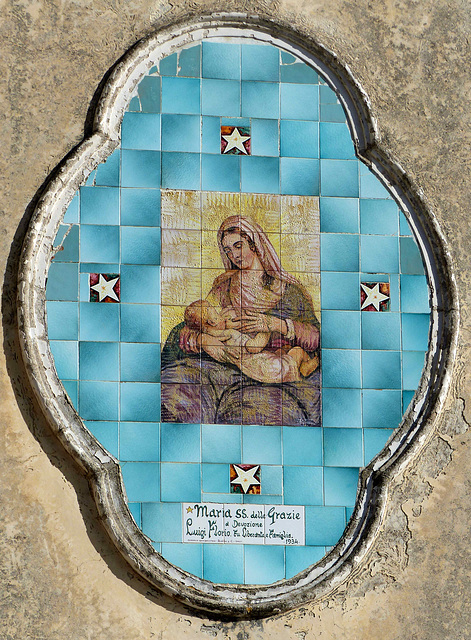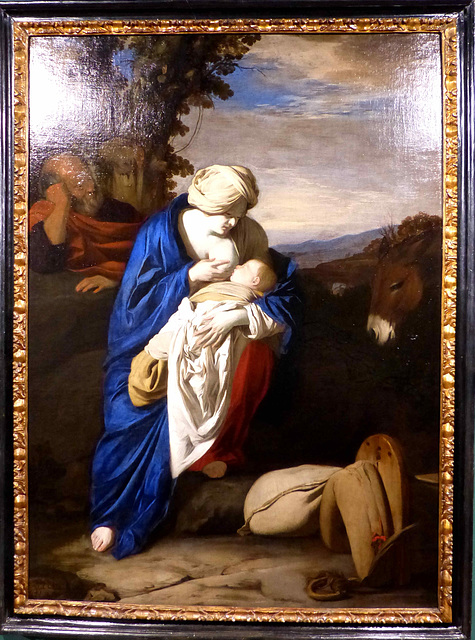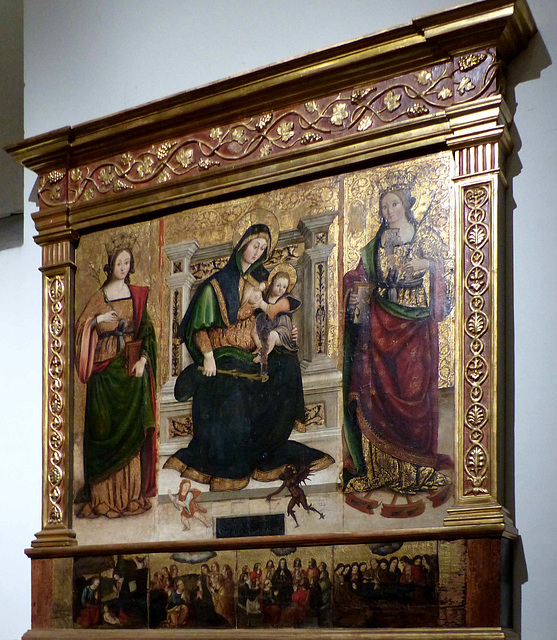
Maria lactans
The nursing Madonna is an iconography of the Madonna and Child in which Mary is depicted nursing the infant Jesus. It is a very popular image, because noble women usually had wet nurses.
Abbazia di Chiaravalle di Fiastra
In 1142 Guarnerio II, Duke of Spoleto and Marquis of Ancona, donated a large piece of land here to the Cistercians. The monks from the Abbazia Chiravalle in Milan arrived that same year and immediately began building the monastery. They used material from the ruins of the nearby Roman city of Urbs Salvia, which had been destroyed by Alaric in 408-410 and also began the reclamation of the swampy forest around.
The abbey flourished for three centuries. The monks organized their agricultural land and its influence grew to the extent that it incorporated 33 dependent churches and monasteries. In 1422 the abbey was sacked by condottiero Braccio da Montone, who destroyed the roof of the church and the bell tower, and killed a number of the monks.
Subsequently, the Pope entrusted the abbey to a group of eight cardinals as a prebend. In 1581, the abbey was assigned to the Jesuits. Finally, in 1773, after the suppression of the Jesuits, the whole area was handed over to the Bandini family. The last heir of the family left the area to the present Giustiniani-Bandini Foundation, which set up the Fiastra Abbey Nature Reserve to preserve this heritage.
A "Maria lactans" (Nursing Madonna, Italian "Madonna del Latte") was a common icon (especially among the Cistercians) until after the Council of Trent (1545/1546), rather rejected for reasons of decency.
Atri - Basilica di Santa Maria Assunta
Atri was known as Hadria when the Romans founded a colony here in 282BC. Roman emperor Hadrian's family originally derived from this place. After the fall of the Roman Imperium, the Lombards established hegemony over the area in the 6th century and Atri got annexed to the Duchy of Spoleto. The Lombards were displaced by the Normans, whose noble House of Acquaviva family ruled the town from about 1393, before merging their lands into the Kingdom of Naples in 1757.
The present cathedral has several predecessor buildings, that were founded in the ruins of a Roman thermal from the 2nd century. It was consecrated in 1223. Reconstructions occurred during the following two centuries. The sober white stone façade has a large portal designed by Raimondo del Poggio and Rainaldo d'Atri between 1288 and 1305.
The interior of the cathedral was once covered with frescoes. Some were rediscovered in the 19th and 20th centuries under a thick layer of plaster.
This fresco was created in the middle of the 14th century by an anonymous painter called "Maestro di Offida" (Master of Offida).
Only the central part of this work has been preserved and shows the nursing Madonna and Child (Madonna del Latte) between three saints.
Matera - Santa Lucia alle Malve
The original settlement of Matera lies in two canyons carved by the Gravina River. This area, the Sassi di Matera, is a complex of cave dwellings carved into the ancient river canyon. The settlement is divided into the districts of Sasso Barisano and Sasso Caveoso.
The cave settlements in the area are an exceptional example in the Mediterranean area. Inhabited since the Neolithic Age, Matera can be considered one of the oldest cities in the world.
According to Greek, Roman, Langobard and Byzantine history, which Matera shares with all of southern Italy, Saracens devastated the place in 938. It came under Norman rule in 1043, became a royal seat and thus achieved considerable wealth. This bloom continued under the subsequent regiments of the Staufer and Anjou, in 1270 the cathedral of Matera was completed.
Already by the late 1800s, Matera's cave dwellings became noted for intractable poverty, poor sanitation, meager working conditions, and rampant disease. In 1948, when the city was hit by malaria, 15,000 people lived in 3,300 rooms. From the 1950s on the residents were relocated to newly built apartment blocks. Since the Sassi are now a museum town, tourism is also becoming increasingly important.
Known as la città sotterranea ("the underground city"), the Sassi and the park of the Rupestrian Churches were named a UNESCO World Heritage Site in 1993. In 2019, Matera was declared a European Capital of Culture.
Today Matera has a population of about 60.000, who live in the city "above" the sassi. Dozens of small rock-hewn chapels, churches and former hermitages are carved into the rocks here.
The church of Santa Lucia alle Malve is the first female monastic settlement of the Benedictine Order, dating back to the VIII century. The nunnery has been an integral part of the life of Matera, following its historical-urban development over the course of a millennium. Santa Lucia alle Malve is a church in rock of considerable size that develops in three distinct naves. Despite having undergone heavy upheavals, after the abandonment by the monastic community in 1525, the structure is clearly visible.
Of the three aisles that articulate the interior space, the right one, in which it is the current entrance, has always remained open to worship, so much so that even today on the day of Saint Lucia, December 13, there is a solemn mass here; the other two naves were transformed into dwellings and stores until the 1950s.
On the interior walls are valuable frescoes, many of which were found during the 1977 restoration and date from the 12th century.
The "Maria lactans" ("Madonna del Latte") is dated around 1270 and probably created by the "Master of Bruna", who painted as well the "Madonna della Bruna" in Matera´s Cathedral.
Since I have already uploaded many photos from Matera from previous trips, I will only add a few now.
If you want to see more photos from Matera, click here:
www.ipernity.com/doc/323415/album/1334046
Salerno - Cattedrale di Salerno
Salerno (pop. ~ 130.000) is located on the Gulf of Salerno on the Tyrrhenian Sea. The site has been one of the most important and strategic ports on the Mediterranean sea, yielding a rich Greco-Roman heritage. It was an independent Lombard principality in the early Middle Ages. The Normans in 1077 made Salerno the capital of their rule in all of southern Italy. In the 16th century, under the Sanseverino family, among the most powerful feudal lords in southern Italy, the city became a center of learning, culture, and the arts.
Salerno has been the seat of an archbishop since 983 and the city's medical school is famous for being the first college or "university" of medieval Europe.
The construction of the Cathedral was begun by Robert Guiscard in 1076. This was just three years after the Normans took over the city, which had previously been under Lombard rule for more than 400 years. The church, built on an early Christian church, that was built on the ruins of a Roman temple, was consecrated in 1084 and completed in 1085.
Due to the short construction time, cracks formed repeatedly in the building over the centuries. After severe damage from an earthquake in 1688, the cathedral was restored with baroque alterations. In the 20th century, attempts were made to reconstruct the original facade.
A "Maria lactans" (Nursing Madonna, Italian "Madonna del Latte") was a common icon (especially among the Cistercians) until after the Council of Trent (1545/1546), rather rejected for reasons of decency.
Salerno - Museo Diocesano San Matteo
Salerno (pop. ~ 130.000) is located on the Gulf of Salerno on the Tyrrhenian Sea. The site has been one of the most important and strategic ports on the Mediterranean sea, yielding a rich Greco-Roman heritage. It was an independent Lombard principality in the early Middle Ages. The Normans in 1077 made Salerno the capital of their rule in all of southern Italy. In the 16th century, under the Sanseverino family, among the most powerful feudal lords in southern Italy, the city became a center of learning, culture, and the arts.
Salerno has been the seat of an archbishop since 983 and the city's medical school is famous for being the first college or "university" of medieval Europe.
The Diocesan Museum is best known for the "Salerno Ivories". A collection of ivory plaques from around the 11th or 12th century that contain elements of Early Christian, Byzantine, and Islamic art as well as influences from Western Romanesque and Anglo-Saxon art, but there is much more.
The "Madonna della Gracia" is attributed to Domenico Napolitano / 16th. century
Conca dei Marini - San Michele
The "Costiera Amalfitana" - Amalfi Coast, overlooking the Tyrrhenian Sea and the Gulf of Salerno, has been (rightly) one of the places of longing for northern European tourists for about 300 years.
Meanwhile, the Amalfi Coast attracts large crowds of international tourists, especially in the summer. In 1997, the coasts were included in the UNESCO World Heritage List.
We had rented a small apartment and could see San Michele from the balcony. The facade of the church has been decorated with this "Maria Lactans" since 1936.
Napoli - Complesso Monumentale Donnaregina
Napoli is the regional capital of Campania and the third-largest city of Italy. Its metropolitan area has a population of more than 3 million.
Founded by Greek settlers before 900 BC, Napoli was an important part of Magna Graecia and played a major role in the merging of Greek and Roman society.
Following the decline of the Western Roman Empire Napoli was shortly ruled by the Ostrogoths. Byzantine troops captured the city in 536m but after the Byzantine exarchate Ravenna fell a Duchy of Naples was created. Over centuries the Duchy´s relations to Rome or Byzanz were hard-fought. In 836 Napoli could repel a siege of Lombard troops with the help of the Saracens, what did not prevent Muhammad I Abu 'l-Abbas in the 850s loot Napoli. In the 11th century, the Duchy hired Norman mercenaries and about 1140 it came under Norman control under Roger II, then King of Sicily.
In 1228 Emperor Frederick II founded the first university in Europe here, making Napoli the intellectual centre of the kingdom. The conflict between the House of Hohenstaufen and the Papacy led in 1266 to Pope Innocent IV crowning the Angevin duke Charles I King of Sicily. Charles officially moved the capital from Palermo to Napoli.
In 1282 after the "Sicilian Vespers", a successful rebellion on the island of Sicily against the rule of King Charles I, the Kingdom of Sicily was divided into two. The Angevin Kingdom of Naples included the southern part of the Italian peninsula, while the island of Sicily became the Aragonese Kingdom of Sicily.
By the 17th century, Naples had become Europe's second-largest city – second only to Paris – with around 250000 inhabitants.
The "Complesso Monumentale Donnaregina" consists of two churches. The younger "Donnaregina Nuova" from the 17th century and the "Donnaregina Vecchia" from the 14th century. Today the complex houses the "Museo Diocesano".
Riposo nella fuga in Egitto / Rest on the Flight into Egypt
Aniello Falcone, 1641
Napoli - Complesso Monumentale Donnaregina
Napoli is the regional capital of Campania and the third-largest city of Italy. Its metropolitan area has a population of more than 3 million.
Founded by Greek settlers before 900 BC, Napoli was an important part of Magna Graecia and played a major role in the merging of Greek and Roman society.
Following the decline of the Western Roman Empire Napoli was shortly ruled by the Ostrogoths. Byzantine troops captured the city in 536m but after the Byzantine exarchate Ravenna fell a Duchy of Naples was created. Over centuries the Duchy´s relations to Rome or Byzanz were hard-fought. In 836 Napoli could repel a siege of Lombard troops with the help of the Saracens, what did not prevent Muhammad I Abu 'l-Abbas in the 850s loot Napoli. In the 11th century, the Duchy hired Norman mercenaries and about 1140 it came under Norman control under Roger II, then King of Sicily.
In 1228 Emperor Frederick II founded the first university in Europe here, making Napoli the intellectual centre of the kingdom. The conflict between the House of Hohenstaufen and the Papacy led in 1266 to Pope Innocent IV crowning the Angevin duke Charles I King of Sicily. Charles officially moved the capital from Palermo to Napoli.
In 1282 after the "Sicilian Vespers", a successful rebellion on the island of Sicily against the rule of King Charles I, the Kingdom of Sicily was divided into two. The Angevin Kingdom of Naples included the southern part of the Italian peninsula, while the island of Sicily became the Aragonese Kingdom of Sicily.
By the 17th century, Naples had become Europe's second-largest city – second only to Paris – with around 250000 inhabitants.
The "Complesso Monumentale Donnaregina" consists of two churches. The younger "Donnaregina Nuova" from the 17th century and the "Donnaregina Vecchia" from the 14th century. Today the complex houses the "Museo Diocesano".
This fresco was in the Napoli Cathedral before it was taken to the museum- It was created before 1432 and is attributed to Domenico de Montepulciano.
Napoli - Complesso Monumentale Donnaregina
Napoli is the regional capital of Campania and the third-largest city of Italy. Its metropolitan area has a population of more than 3 million.
Founded by Greek settlers before 900 BC, Napoli was an important part of Magna Graecia and played a major role in the merging of Greek and Roman society.
Following the decline of the Western Roman Empire Napoli was shortly ruled by the Ostrogoths. Byzantine troops captured the city in 536m but after the Byzantine exarchate Ravenna fell a Duchy of Naples was created. Over centuries the Duchy´s relations to Rome or Byzanz were hard-fought. In 836 Napoli could repel a siege of Lombard troops with the help of the Saracens, what did not prevent Muhammad I Abu 'l-Abbas in the 850s loot Napoli. In the 11th century, the Duchy hired Norman mercenaries and about 1140 it came under Norman control under Roger II, then King of Sicily.
In 1228 Emperor Frederick II founded the first university in Europe here, making Napoli the intellectual centre of the kingdom. The conflict between the House of Hohenstaufen and the Papacy led in 1266 to Pope Innocent IV crowning the Angevin duke Charles I King of Sicily. Charles officially moved the capital from Palermo to Napoli.
In 1282 after the "Sicilian Vespers", a successful rebellion on the island of Sicily against the rule of King Charles I, the Kingdom of Sicily was divided into two. The Angevin Kingdom of Naples included the southern part of the Italian peninsula, while the island of Sicily became the Aragonese Kingdom of Sicily.
By the 17th century, Naples had become Europe's second-largest city – second only to Paris – with around 250000 inhabitants.
The "Complesso Monumentale Donnaregina" consists of two churches. The younger "Donnaregina Nuova" from the 17th century and the "Donnaregina Vecchia" from the 14th century. Today the complex houses the "Museo Diocesano".
The painting was created by an unknown Neapolitan artist in the early 16th century. It is known under the name "Madonna del Soccorso" (Lady of Succour).
Jump to top
RSS feed- Latest items - Subscribe to the latest items added to this album
- ipernity © 2007-2024
- Help & Contact
|
Club news
|
About ipernity
|
History |
ipernity Club & Prices |
Guide of good conduct
Donate | Group guidelines | Privacy policy | Terms of use | Statutes | In memoria -
Facebook
Twitter










